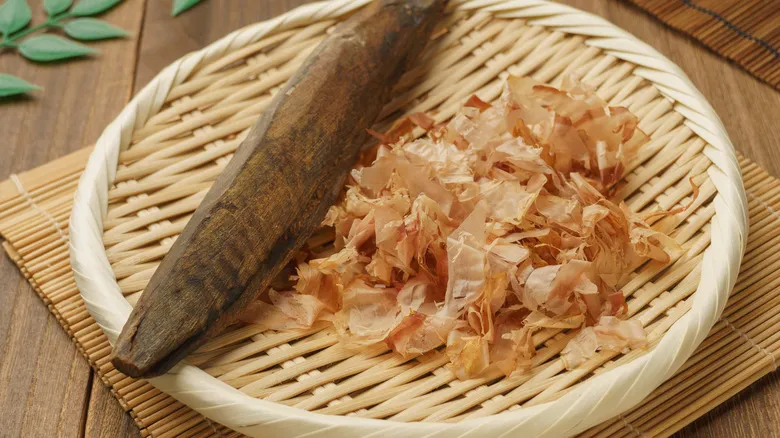Rethink your main ingredients

The simplest way to enhance a vegetable stock is by altering its fundamental ingredients. One method is to swap out milder staples, such as potatoes and onions, for more flavorful options like sweet potatoes, leeks, or daikon radish. Another strategy is to add extra vegetables to the pot beyond the usual suspects. Glutamate, an amino acid, is the key contributor to umami flavors and is present in various meats and vegetables in differing amounts. It can be found in kelp and seaweed (grinding sheets of nori into a powder is a quick way to infuse umami), as well as in foods like spinach and tomatoes.
Other tasty additions for a stock rich in umami include bamboo shoots, lotus root, and edamame. You can even roast and incorporate onion peels instead of throwing them away. However, be cautious with certain high-glutamate vegetables, such as kale and cauliflower, as they can become bitter if overcooked. It’s best to add them towards the end of cooking or skip them entirely.
If you’re seasoning your stock, consider using MSG (monosodium glutamate) to replace some of the salt for a flavor boost. Don’t be concerned: the belief that MSG causes negative reactions in most people is a myth. In fact, MSG was discovered by a scientist in 1908 who was trying to identify what made kelp so delicious, and he coined the term umami ("delicious taste") to describe it.
Reconstitute dried mushrooms for the liquid

Dried mushrooms possess a richer umami flavor compared to their fresh counterparts, as the drying process transforms complex proteins into glutamate. You can use them to create varying levels of umami-rich liquid, which can enhance traditional stock. Simply take a packet of Marky's Dried Whole Shiitake Mushrooms and soak them in lukewarm water for 20 to 30 minutes. This will yield two delightful results: rehydrated mushrooms (which can be added to the stock or used in other recipes) and a deeply savory, earthy mushroom tea. In fact, this method is one way to prepare dashi, a flavorful stock commonly used in Japanese cuisine. Dashi is often incorporated into eggs for tamagoyaki and is essential for a good teriyaki sauce.
While making a large batch of dashi can be costly, it’s an excellent way to create a flavorful liquid that can be added in varying amounts to your main stock. This technique is applicable to any dried mushrooms, but shiitake mushrooms are known for delivering some of the most intense umami flavors.
Take your cues from miso soup

Authentic dashi is crafted using fresh or preserved ingredients, time, and sometimes fermentation. However, many Japanese households opt for instant dashi powder to enhance their dishes with a burst of umami. Known as dashi no moto, this powder consists of tiny granules that deliver intense flavor, similar to miniature bouillon cubes. A popular brand, Ajinomoto Hondashi bonito soup stock, provides a subtly oceanic umami flavor, complemented by notes of smokiness and sweetness. Just a small amount added to your stockpot can significantly enhance its depth and complexity.
While dashi is essential for preparing miso soup, the other key ingredient is miso paste, a thick, vegemite-like substance made from fermented soybeans, salt, and koji mold. It is incredibly rich, so a little goes a long way. The typical recommendation is about a tablespoon per serving, but this may not scale linearly. It's best to add it gradually, one tablespoon at a time, until you achieve your desired flavor. Since miso paste is high in salt, you won’t need to season your stock or broth as heavily as you usually would.
Make a roasted vegetable stock

Vegetable stock is typically prepared using fresh vegetables, often whatever is available. Many individuals who consume a lot of veggies throughout the week save their scraps in the fridge or freezer until they have enough to make stock. However, there's no reason you can't roast a selection of carrots, celery, onions, garlic, and daikon specifically for the purpose of adding them to a pot of boiling water. The advantage of this approach is that the caramelization that occurs in the oven enhances the stock with rich flavor and color.
Arrange the vegetables—whether scraps or chopped pieces—on a baking sheet and drizzle with oil, just like you would for any roasted vegetable dish. Sprinkle with freshly ground pepper and your choice of spices, but you might want to hold off on adding salt if you plan to season the stock later. Be mindful of common mistakes that can prevent you from achieving perfectly roasted vegetables, even if you intend to simmer them thoroughly afterward. Avoid using leafy greens that could burn and impart bitterness. This is also not the best time for broccoli or cauliflower, as they can overpower the stock after roasting. Depending on the amount of oil used during roasting, you may need to skim off excess oil as the stock simmers.
Bonito flakes give fishy depth to stock or broth

When you incorporate bonito flakes into your mixture, it transforms from a simple vegetable stock. Bonito flakes, also known as katsuobushi, are made from dried fish—specifically skipjack tuna—and are a key ingredient in Japanese dashi. These delicate, flavorful flakes are also commonly used as a seasoning for rice.
You can purchase bonito flakes in various sizes, including one-pound bags like those from Yamahide Hana. A little goes a long way; typically, you'll need between ½ and 1 tablespoon of flakes for each cup of water. For an even richer dashi, consider combining bonito flakes with a piece of kombu seaweed. This mixture can serve as your main stock base, or if you prefer just a subtle umami flavor, you can gradually add it to regular salted water. Keep in mind that adding bonito flakes means your vegetable stock may no longer be suitable for vegetarians or vegans.
Recommended

Is There A Difference Between White And Brown Parchment Paper?

Fish Cheeks Are The Underrated Cut Of Meat You're Missing Out On

The Simple Swap You Need For Dairy-Free Curry. (It's Not Coconut Milk)

This Genius Tip Helps You Fit More Food In Your Buffet Space
Next up

